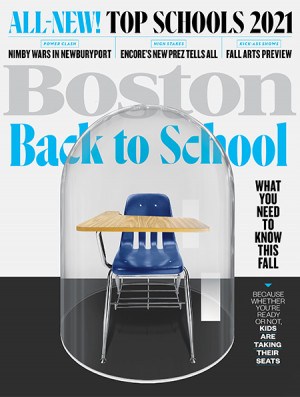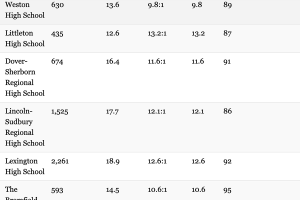The Best Schools (For You and Your Kid)
Public versus private. It's an age-old debate in these parts, but today parents all over the Hub are reexamining their long-held assumptions about what's best for their kids.

Photography by Blake Fitch
Is a Private School Education Still Worth It?
By Sascha de Gersdorff
My father was a St. Mark’s man. So was his father. And his cousins. Their paths to success, it was assumed, were cut straight through a world of stone corridors and well-manicured quads. For families like ours, a “good education” meant just one thing: private school. Such institutions were, quite simply, where one went. I enrolled at Deerfield; my sister, St. Mark’s.
What began with some long-dead relative as the narrow notion that private school conferred status had, by my time, softened into merely a subtle reflex. I never questioned or wrestled with the merits of public versus private; I enrolled in a prep school confident I’d emerge primed for success. And while I wouldn’t trade the experience for anything, I sometimes wonder whether that pricey education was worth as much as my family assumed it was—and whether our long-established attitude wouldn’t seem a tad outdated today.
It’s not an uncommon line of questioning these days. All over Greater Boston, families who never doubted their paths are suddenly debating what a “good education” looks like—and what it should cost. In the midst of this current economic reckoning, parents across the Hub are weighing the sorts of sacrifices needed to cover what is, on average in these parts, a $23,000-a-year price tag. And in a region where already superb public schools seem to get better by the year, many are asking a more basic question: Why should they pay at all?
“They’re gone. They’re gone. They’re gone…”
Susan White is reading down her son’s class list, checking off names. “I swear the kids are all leaving,” she says. “There’s no one left.” White has two children at a Boston-area private school and, like the other parents interviewed for this story, asked that her name be changed lest she run afoul of old Yankee prohibitions on discussing money publicly. And money is at the heart of what we’re talking about here. Many of White’s fellow private school parents, victims of layoffs or Madoff-ized life savings, are pulling their children out of private school because they can’t pay—or no longer want to pay—the high tuition. “Is it worth it?” she asks. “I can tell you, this is all we talk about.”
Given the average local prices, a prep school–minded family with three kids will shoulder a burden of $276,000 just to get their progeny through high school. Back up to preschool—which can reach $20,000 per kid per year—and then tack on elementary and middle years ($22,000 per year), and they’re looking at another $648,000. Add college to the mix, and the bill is well over $1 million.
That’s a lot of cash, especially when you remember that the humble, tuition-free public school down the street—most notably in places like Concord, Newton, Brookline, and Wellesley—is likely to be about as good as any school in the country.
Plenty of parents are doing the math. And while there are certainly those who have tied themselves to the mast of private education, vowing to do anything to weather high tuitions in harsh times, many others are making a move. Michael Spence, a Back Bay educational consultant who’s advised Boston families for more than 25 years, says uneasiness about the economy has parents weighing their options in ways they haven’t before. “The people I talk to are those who could pay the tuition,” he notes, “but the perception about their income and lack of clarity about their future has them thinking twice, even if they can afford the 50-grand price tag.”
That’s how it went for the South End’s Marcia Reardon. With two children in private school, her family’s education bill totaled around $40,000 per year—a reality made worse now that her husband is out of work. After much discussion and debate, their kids will attend public school this year, putting the Reardons in the vanguard of private school people going public. Already, they’re working on a new attitude. “We’re trying to keep an open mind about public school,” she says, a note of uncertainty in her voice.
One senior who is returning to a private school that’s reportedly lost 25 students from its rolls offered a more sanguine assessment of her friends’ experience in local public schools. “A lot of kids are moving to Wellesley High this year,” she says. “I don’t think they’ll be suffering.”
Indeed, across Greater Boston, public schools are happily fielding the influx. “Our doors are wide open,” notes Bob Weintraub, headmaster at Brookline High School, where enrollment is up 25 percent. “How ready is Brookline High to take care of these kids? We’re very ready. We want a 100 market share.” The public schools in Newton, Weston, and Boston proper, among others, have also reported enrollment bumps. And indeed, though there are big challenges facing some cash-strapped school districts, it’s also true that our great public schools have never been better. “Parents here need a pretty good reason to send their kids to private school,” says Paul Ash, Lexington Public Schools superintendent. “Our education is outstanding, and if enrollment goes up, it’s no big deal.”
Squadrons of AP classes, research trips to Peru or Japan, plentiful art and music studios, natatoriums that would make Michael Phelps feel at home. These are the much-talked-about hallmarks of private schools, the kinds of things few public institutions can match. But while that Chinese immersion program is impressive, the siren call of a private school education has always been the access it provides to elite colleges. “In these schools, the process of getting into college begins right away,” says Ruben Gaztambide-Fernandez, whose new book, Best of the Best, is a study of the New England prep school experience. “That’s what they use to attract students in the first place.”
When I was in high school, there was much talk about “feeder schools.” Andover and Exeter were the routes to Harvard and Yale, St. Paul’s to Princeton, Deerfield to Dartmouth. But as universities put more and more emphasis on diversifying their student bodies, they’re no longer happy to accept a handful of bright kids from the country’s top private high schools. “Attending a private school increases your chances of getting into a good college but decreases your chances of getting into a really good college,” says Gaztambide-Fernandez. “A lot of these students could have done very well in their local public schools, and maybe that would have put them in a better place to get into Harvard or Yale. In an elite school, they’re competing with many of the same types of students; it’s harder to stand out. There’s a chance going private might actually diminish your college chances.” Discouraging news for parents working their way toward that $1 million education.
The scenario has ratcheted up the need for private schools to remind families what they can provide. “Independent schools are feeling a lot of pressure to justify their value,” says Sudbury-based educational consultant Allison Matlack. “They haven’t had to prove their worth like this before.” In a bid to reassure anxious parents, headmasters are mailing home more details on their school’s programs and offerings. One local school recently organized a class project designed to remind students what their families might be sacrificing for their superior education. Everywhere, outreach has been amped up as private schools “massage” their existing students, says one local mom. “They’re organizing events—holiday fairs, potluck suppers, guest speakers, Valentine’s Day breakfasts,” she notes. “Of course, these are all marketing gimmicks, but they’re effective at building a community that makes people feel more invested.”
Most of all, though, private schools are getting more vocal about their financial-aid opportunities. Across the region, requests for aid are up—15 percent at Milton, 20 percent for new students at Belmont Hill, and 25 percent for applicants to Buckingham Browne & Nichols. At Concord Academy, 25 percent of students will be receiving aid this year, up from 20 last year. To offset the cost, schools are engaged in aggressive fundraising and are making grateful use of scholarships provided by wealthy benefactors. The programs mirror the kind of scramble more commonly seen at the college level. “Our school has announced many times this year that it was increasing its financial-aid packages,” says a mom with two children in a Newton
private school. “Sometimes people see a stigma in financial aid. They think, ‘I don’t want to be that person who applies.’ Our school has tried to take that stigma away this year; communication has been ramped up. The school has made financial aid a priority.”
Hanging on to existing students may be the top concern, but private schools are also going further afield to find new kids, too. School fairs that were once pamphlet-distribution events are now seen as critical opportunities to capture a student’s allegiance. “I’ve been to fairs with more than 100 other schools,” says Mike Brennan, Boston College High School admissions director. “This is a fierce market. The stakes are higher.”
And it’s a job not left to merely the admissions office. Coaches are on the phone, hard-selling sports teams and facilities; algebra teachers are dialing future mathletes; and painting instructors are checking in with would-be Picassos. The plus side of any enrollment shakeout is that private schools still have seats to fill. With nary a hiccup in transferring her kids to a private school late in the academic cycle, one mom says, “This makes me think if you wanted to get into BBN, now is the time.”
If the security blanket that elite private schools have long provided appears a bit frayed today, that may not necessarily be a bad thing. Even as the economy has forced families to reevaluate their assumptions, it’s also helped show them they have options—great ones. “What this has done is really open up all the possibilities,” says longtime educational planner Adam Goldberg. And for the first moment in decades, parents are beginning to actively explore what those possibilities look like.
It’s about time.
Already, our great private schools have recognized they can’t rest on their gilded crests in the hope that eager young things will barrel toward campus waving applications and tuition checks. And already, plenty of well-off parents with high expectations and a penchant for getting involved are joining their public school communities. A little competition for students—a little tussling over the idea of what makes a “good education”—is a good thing.
Maybe my future kids will be St. Mark’s kids. Or maybe they’ll step into public school classrooms. Either way, they’ll be aiming for the best, not merely making a stop on a predetermined path.

